Understanding Bathroom Roof Ventilation
Basically, bathroom roof ventilation is all about getting the moist, stale air from your bathroom out of your house and into the open air. Think of your bathroom fan – that whirring thing you turn on when you shower. It pulls air, and that air has to go somewhere, right? Instead of just dumping it into your attic or walls (which is a big no-no), a bathroom roof vent acts as the exit. This usually involves a duct running from the fan up to a special vent cap on your roof. This setup, often called a bath exhaust roof vent or simply a bath roof vent, is key to keeping your bathroom air fresh and your home dry. It’s a pretty simple concept, but getting it right makes a huge difference.
How Does it Work?
It’s not super complicated. When you switch on your bathroom fan, it creates suction. This suction pulls the humid air, along with any lingering odors, through a duct. This duct then leads directly to the exterior of your home, typically through the roof via a dedicated bathroom roof vent. This vent is designed to let air out but keep rain, snow, and pests from getting in. Some vents are pretty basic, while others have features like backdraft dampers to prevent outside air from coming back in. The whole point is to create a clear path for that moist air to escape your home’s structure. Without a proper path, that moisture can cause all sorts of problems, leading to potential roof repair needs down the line.
The primary goal of a bathroom roof vent is to expel moist air directly outside, preventing it from accumulating within your home’s walls or attic space. This simple act is a major defense against moisture-related damage.
Here’s a quick rundown of the process:
- Fan Activation: You turn on your bathroom fan.
- Air Intake: The fan pulls humid air and odors from the bathroom.
- Duct Transport: The air travels through a duct system.
- Exterior Exhaust: The air is expelled through a bath roof vent on your roof.
Different types of vents exist, and choosing the right one depends on factors like your roof’s pitch and the length of the duct run. For instance, some vents are designed for low-slope roofs, while others work better on steeper pitches. Making sure the vent is installed correctly is just as important as the type of vent itself. If you’re unsure about the installation, it’s always a good idea to connect with local roofing specialists in Ottawa.
- Air Diverters: Good for long duct runs, they help direct airflow.
- Roll-Up Vents: Often used on flat roofs.
- Sliding Vents: Compact and efficient for direct mounting.
Getting this system right means your fan works efficiently and your home stays healthier. It’s a small part of your home’s system, but it plays a big role in preventing bigger issues.
The Crucial Role of Ventilation in Ottawa Homes

Living in Ottawa means dealing with some pretty distinct weather. We get those cold, dry winters and humid summers, and that really puts a strain on our homes. Without proper ventilation, especially in places like bathrooms, moisture can build up fast. This isn’t just about a steamy mirror after a shower; it’s about protecting your whole house.
Preventing Mold and Mildew Growth
Bathrooms are prime real estate for mold and mildew. All that hot water and steam create a perfect breeding ground. If the moist air can’t escape, it settles on walls, ceilings, and in hidden spots. Over time, this leads to unsightly mold growth and that musty smell. It’s not just gross; mold can cause respiratory problems and damage your home’s surfaces. Good ventilation is your first line of defense against these unwelcome guests.
Protecting Your Home’s Structure
That moisture doesn’t just sit on the surface. It can seep into your walls, insulation, and even the roof structure. In a cold Ottawa winter, this trapped moisture can freeze and expand, causing damage. In warmer months, it can lead to rot and decay. Over years, this can weaken your home’s integrity, leading to costly repairs. Think of ventilation as a way to keep your home’s bones healthy.
Improving Indoor Air Quality
Beyond just moisture, bathrooms can harbor other less-than-pleasant things like cleaning chemical fumes and lingering odors. Proper ventilation helps to clear these out, replacing stale indoor air with fresh outdoor air. This makes your home a more comfortable and healthier place to be. It’s especially important for families with young children or anyone with allergies or breathing issues. Good ventilation is a key part of effective Ottawa home ventilation solutions.
Reducing Energy Costs
It might seem counterintuitive, but good ventilation can actually save you money. When your bathroom is properly ventilated, your heating and cooling systems don’t have to work as hard to manage humidity levels. Over-humid air feels warmer, so you might turn down the thermostat in summer. In winter, preventing moisture buildup on windows means less heat loss. It’s about creating a balanced environment, not just blasting air conditioning or heat.
Proper ventilation systems work to remove excess moisture and stale air, replacing it with fresh air. This process helps maintain a comfortable living environment and prevents the buildup of pollutants and humidity, which can lead to structural damage and health concerns over time.
Signs You Need Better Bathroom Roof Ventilation
Sometimes, you don’t realize there’s a problem until it’s staring you right in the face, or maybe, you can just smell it. Your bathroom roof ventilation system is one of those things that works quietly in the background, but when it’s not doing its job, the signs can become pretty obvious. If you’re noticing a few things out of the ordinary in your bathroom, it might be time to take a closer look at how that moist air is getting out of your house.
Visible Signs of Moisture
This is usually the most telling stuff. Think about what happens when you take a long, hot shower. That steam has to go somewhere, right? If your ventilation isn’t up to snuff, that moisture hangs around. You might start seeing:
- Condensation on windows and mirrors: This is a classic sign. If your bathroom windows are constantly fogged up, even when it’s not particularly humid outside, that’s a red flag.
- Peeling paint or wallpaper: Moisture that’s trapped can start to warp and peel paint or wallpaper, especially around the ceiling and upper parts of the walls.
- Water stains: Look for discoloration on your ceiling or walls, particularly near light fixtures or vents. This indicates water is pooling and potentially leaking.
- Damp spots on the ceiling or walls: Beyond just stains, you might feel actual dampness if you touch these areas.
Lingering Odors
Beyond just the general
Solutions for Effective Bathroom Roof Ventilation

So, your bathroom is feeling a bit damp, or maybe you’ve noticed some musty smells that just won’t quit? It’s time to think about your bathroom roof ventilation. This isn’t just about making your bathroom smell nicer; it’s about protecting your home.
There are a few ways to tackle this. Sometimes, it’s as simple as upgrading your existing setup. If your bathroom fan is old, say over 15 years, it might not be doing the best job. A newer fan, paired with a proper roof vent, can make a big difference in how well moisture and odors are removed. Even if your fan seems to be working, adding or replacing the roof vent itself can seriously boost its performance. Think of it like giving your fan a better exhaust pipe.
Here are some common solutions to consider:
- Upgrade Your Bathroom Fan and Vent: If your fan is aging or you’ve recently remodeled, a new, energy-efficient fan with a dedicated roof vent is a smart move. Modern fans are quieter and more effective at clearing out humidity.
- Install a Proper Roof Vent: Even with a decent fan, the vent on your roof might be blocked, too small, or just not designed for the job. Replacing it with the right type of vent, like an air diverter for low-pitched roofs or a roll-up vent for flatter ones, can improve airflow significantly.
- Ensure Correct Vent Sizing and Placement: The size of the vent matters, and it often depends on your roof’s pitch. Generally, you want a bit of clearance between the fan duct and the roof. Getting this right helps prevent airflow issues and keeps water out.
- Consider Continuous Fan Operation: For persistent moisture problems, running your bathroom fan continuously, or using a fan cycling controller, can help mix fresh air throughout the house, especially if you have a forced-air furnace. This is a good way to manage humidity without always having the fan on high.
Getting the right ventilation system in place is key to preventing bigger problems down the road.
When it comes to installing or replacing these components, especially on your roof, it’s often best to call in the pros. They know how to seal everything up tight to prevent leaks and make sure the vent is positioned correctly for optimal airflow. Companies specializing in roofing services can help with drain and vent installation to keep your home healthy and dry.
Sometimes, the simplest solutions are the most effective. Making sure your bathroom fan has a clear path to the outside through a well-installed roof vent is a straightforward way to deal with moisture and keep your home’s structure sound. It’s a small detail that has a big impact on your home’s overall health and comfort, and it can even help with energy savings by reducing the load on your heating and cooling systems. Don’t forget about the importance of a good ridge roofing system for overall home protection too.
Wrapping Up: Why Your Bathroom Needs Proper Ventilation
So, we’ve talked about why it’s important to get that bathroom air moving out of your Ottawa home. Basically, a good exhaust fan hooked up to a vent on your roof is the best way to handle all that steam, smells, and general humidity. Even if your fan seems okay, a better roof vent can really make a difference, helping your system work better and keeping your roof in good shape for longer. If your current fan is loud, doesn’t do much, or is just plain old, swapping it out for a new one is a pretty smart move. It’s not just about making your bathroom feel nicer; it’s about protecting your whole house and making it last.
Frequently Asked Questions
1. Why is bathroom roof ventilation important in Ottawa?
Ottawa’s cold climate traps moisture from showers. Proper roof ventilation removes humid air, preventing mold, ceiling damage, and wood rot in your attic.
2. How do I know my bathroom needs better ventilation?
Look for foggy mirrors, peeling paint, musty smells, or dark mold spots—these are signs your bathroom isn’t venting moisture properly.
3. Can poor ventilation damage my home?
Yes. Trapped moisture can cause wood rot, structural damage, and even roof leaks over time.
4. Does an exhaust fan help save energy?
Absolutely. It reduces humidity so your AC works less in summer and prevents costly moisture damage in winter.
5. Roof vent or wall vent—what’s better?
In Ottawa, roof vents are best. Wall vents can freeze in winter, while roof vents let moisture escape safely year-round.
6. Should I upgrade my fan or roof vent?
Both matter. A strong fan removes air, and a proper roof vent lets it escape. Replacing both ensures better airflow and home protection.

